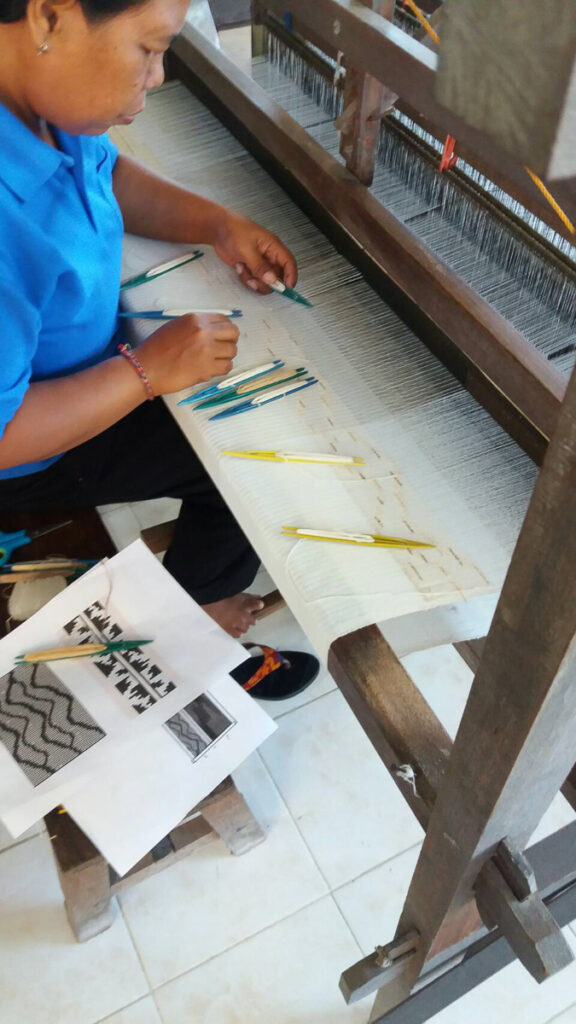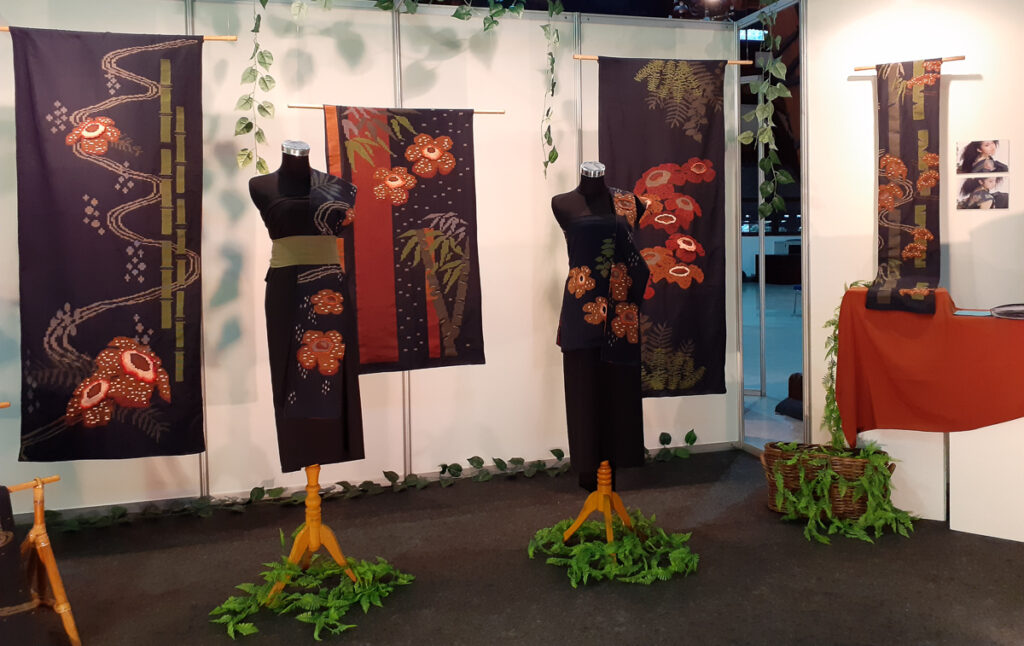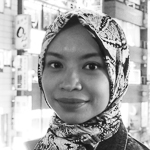
Arlene Dwiasti Soemardi, final project 2, 2018, cotton, 200 cm x 90 cm
Sabrina Sakina writes about the symbiotic arrangement between Bandung designer Arlene Dwiasti Soemardi and local craftsperson Pak Epi and his weaver Andre
(A message to the reader.)
Bandung is the bustling capital city of West Java. It is home to some-thousand colleges and universities and so is known as a “student town”, along with a few other cities in Indonesia, such as Yogyakarta and Malang. Much of the economy in these cities are dependent on campus life, mostly in student and academic activities. It is interesting to note that among the schools in Bandung, there are at least six major colleges and universities that offer textile craft-related courses. I have taught textile courses at two schools in Bandung over the past years, namely Institut Teknologi Bandung and Politeknik STT Tekstil Bandung.
Perhaps the abundance of schools with textiles courses in Bandung is due to the historical fact that it was surrounded by a number of textile and garment factories. Many of these factories have shut down since the downturn of the economy in the Asia Pacific region in the late 1990s. However, a few major factories are still in full operation in the Rancaekek and Leuwigajah area.

Arlene Dwiasti Soemardi, Majalaya weavers, 2018, artisans working on Arlene’s designs
In 2018, Arlene Dwiasti Soemardi, a senior at that time at Institut Teknologi Bandung, began working on her final project. Her idea was to develop weaving patterns based on the landscape of Bali. She had previously explored a weaving workshop in Bali prior to this. However, she soon realized that it would be difficult for her to travel from Bandung to Bali multiple times throughout her final project phase. Financially, it was too expensive. A round-trip flight to Bali could cost up to two million rupiahs, which is equivalent to a month’s minimum wage in Bandung. Physically, it would be exhausting. A one-way journey by train would take up to 15-20 hours of travel. As her supervisor, I suggested that Arlene opt for weaving her project within the closer areas of Bandung.
During this time, I was working on a few weaving projects myself, and one of my yarn suppliers came from Majalaya. Majalaya is a rural town, a part of the greater Bandung region, positioned to the south-east of the main city. Once upon a time, Majalaya was a textile giant, supplying textile needs for the entire nation. These days, the textile industry in Majalaya is smaller in scale and has a more specific market. Among the specialisations of Majalaya are the weaving techniques of the ulos and songket, indigenous supplementary-weft techniques originally from Sumatra but well-adopted by Majalaya craftsmen.
Working with craftspersons is a common occurrence among university students in Indonesia and perhaps a trademark that differentiates the learning process of crafts in this country from other countries. Rather than learning the skills systematically in class, students are often encouraged early on as their sophomore year to seek practical knowledge directly from craftspersons and collaborate to realize design concepts. It helps that these craftspersons charge an affordable rate for student works. Of course, there are downsides to this approach: traditional craftspersons are often reliant on experience, intuition, and feelings, an approach that is difficult to hold accountable in the academic world. Therefore, communicating ideas and designs become a tricky point.
Arlene decided to collaborate with Pak Epi and his weaver Andre for her final project. The craftsperson skills in Majalaya, she tells me, are less detailed than the ones in Bali, but they will suffice and the proximity to campus will allow her more flexibility. There were not many students working with these craftspersons back in 2018. Pak Epi was more focused on accepting orders of ulos from Sumatra. So, Arlene provided a new experience for these weavers. She adapted to their way of working, adjusting her way of drawing draft patterns while allowing the weavers to explore weaving patterns that they would have never thought of making before.
Working with craftspersons also provides new perspectives for the students. Throughout her final project, Arlene realised that she could not simply order a design and expect it to be done by the deadline. It was a nurturing process. Communication was key.

Arlene Dwiasti Soemardi, Majalaya weavers, 2018, artisans working on orders of ulos from Sumatra
A year later in 2019, Arlene’s junior, Anggi Jasmine Avline Aveneina began working on her final project. It was another weaving project. This time, it centred on the idea of introducing the rafflesia through the fabric. Again, I encouraged Anggi to seek for craftspersons to collaborate with, as her motifs were far more complicated than Arlene’s. Anggi worked with not just one weaving workshop, but two. In addition to Pak Epi and Andre, she also approached Pak Asep, my yarn supplier who also had a weaving workshop in Majalaya.
There had been a spike of students working with the weavers. Unlike Arlene who was the sole student in the workshop during her time, Anggi now had several colleagues keeping her company, not just from our university, but from other schools as well. The upside was that the weavers were more experienced in trying various new patterns. The downside was scheduling. The weavers would work on Anggi’s project for a week and then work on another project for the next week, before going back to work on Anggi’s project.

Anggi JA Aveneina, final project, 2019, rayon, 200 cm x 90 cm and 120 cm x 40 cm
These weavers were smart, Anggi concludes. They viewed students as a promotional means to their work, citing they would give discounts for the students now, but later when the students start their own businesses, they will give them full price. So, a mutual relationship was built between the students and the craftspersons.
Arlene is now building her own weaving business, Dhami Anteng. It started when she submitted her final project to ORBIT, a pressure-cooker program dedicated to young designers held by the Indonesian government. She still works with Andre. The pandemic has led to far fewer orders for the weavers in Majalaya, so Arlene’s designs are met with much enthusiasm. Weavers in Majalaya are well-versed in technology, she says. She communicates her designs to Andre through Whatsapp. It helps that the weavers are already familiar with her designs so it’s easier for them to understand despite not meeting face-to-face.

Arlene Dwiasti Soemardi, final project 1, 2018, cotton, 200 cm x 90 cm
Arlene already has two orders from a client lined up, and another one in the works.
What started as an academic relationship has budded into a business relationship. So the mutual symbiosis will continue to provide benefits for the student and the weaver, even after the college years. To sum up, good communication and a nurturing attitude are beneficial for maintaining the relationship between academics and weavers in order to create a future professional relationship.
Further reading
Soemardi, Arlene D. 2018. Jamdani Woven Textile Exploration with Image of Pantai Pandawa as the Inspiration. Bandung: Institut Teknologi Bandung.
Aveneina, Anggi Jasmine Avline. 2019. The Exploration Design Motif of Rafflesia Flower with Supplementary Weft Techniques. Bandung: Institut Teknologi Bandung.
Author
 After graduating college with a degree in textile crafts, Sabrina Sakina dabbled into the magical world of garment production and fashion. A lucky chance led her to an exchange program to Japan, which re-established her curiosity in textiles, specifically structure designing. She is now based in the dynamic town of Bandung, Indonesia, and works on several projects, including topics such as e-textiles and new materials. See @shapby
After graduating college with a degree in textile crafts, Sabrina Sakina dabbled into the magical world of garment production and fashion. A lucky chance led her to an exchange program to Japan, which re-established her curiosity in textiles, specifically structure designing. She is now based in the dynamic town of Bandung, Indonesia, and works on several projects, including topics such as e-textiles and new materials. See @shapby

